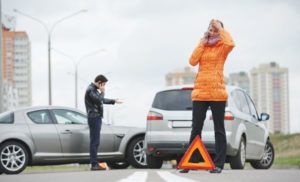Even if you are a very safe driver, there are some common conditions and locations on the road that can increase your chances of being in a crash. Knowing how to handle your car in these conditions or how to avoid these dangers altogether, can help you stay in control of your vehicle.
Common Driving Dangers
Some of the most common road dangers include:
Busy or poorly designed intersections. Intersections are the most dangerous location we travel through each and every day. Forty-three percent of motor vehicle accidents occur at intersections. Sometimes the timing of the lights might make it difficult to make a left turn, or if the roads are narrow, it can be difficult to discern the lanes. Traffic circles are also problematic for many drivers to enter and exit safely. Raising your awareness and keeping your eyes moving will allow you to anticipate potential problems.
Hidden signage. When stop signs or yield signs are obscured by bushes, or are not well marked, drivers may be unaware when they need to stop or yield to oncoming traffic. Keep your eyes scanning the road at all times.
Potholes, ruts or unevenly paved surfaces. A road that hasn’t been well-maintained might be uneven, causing wheels to get stuck and drivers to lose control of the vehicle. This uneven pavement can also deploy airbags if hit with enough force.
Bicyclists. The road needs to be shared with bicyclists, so make sure you’re watching out for those on two wheels.
Work zones. It’s often joked that Northeast Ohio has two seasons: winter and road construction season. That said, work zones are full of people going about their daily jobs, and the speed limits are often slower to account for their safety. Be sure to slow down for construction zones.
Poor overhead lighting. This can be especially dangerous on side streets or country roads, where it can be difficult to anticipate turns or see obstacles in your path at night. If you are having trouble seeing in these situations, slow down and put on your brights (if there is no oncoming traffic). Check your headlights to ensure they are providing adequate light.
Busy Parking Lots and Street Parking. Backing in or out of parking spots provides an easy opportunity to hit or be hit by another vehicle. Some parking tips to reduce your risk of getting a fender-bender:
- Use your turn signal. Using your turn signal is important when parking your car because it alerts other drivers and pedestrians of your intentions.
- Hug the curb. If you’re parallel parking on the road, get as close to the curb as possible. It might take a few tries to get in the right position, but keeping your car closer to the curb means other vehicles will be less likely to side swipe you by accident.
- Get it in gear. Make sure the car is in park before you turn it off. If you’re on a hill, use the emergency parking brake as well. For a car with a manual transmission, put it in reverse if facing downhill and in first gear if facing uphill.
- Use your mirrors, windows, and if available, backup camera. Use all the tools you have available to avoid backing right up into an accident. Never rely solely on just your mirrors, as your blind spot could potentially hide someone or something coming your way. Turn and look in all directions before backing up.
- Read the signs. Parking where you’re not supposed to park increases your chances of being hit by another vehicle that doesn’t expect you to be there. This rule is true for parking lots, garages and the street. Park only in legal spaces and follow the directions for traffic flow.
- Pull all the way into the spot and then straighten out. Upon exiting your car, if you notice that you’re crooked or not all the way forward, get back in your car and fix your position. Likewise, try to avoid parking next to a car that is parked at an angle in a space.
Drive Team offers driver training programs for all ages. We have a comprehensive training program for teens and new drivers, as well as specialized programs for corporate drivers. Contact us for more information.

I have noticed that some younger drivers and others, are driving with the auto lights on, instead of turning the actual headlights on. Relying on the day time driving lights. This is not safe, because some vehicles do not turn on all light in this “auto and driving lights
Plus it’s a violation when raining and1/2 hour after sunset. Turn your Headlights on, not auto and driving lights.